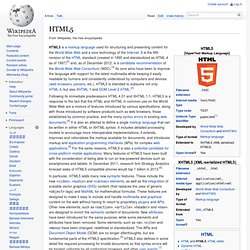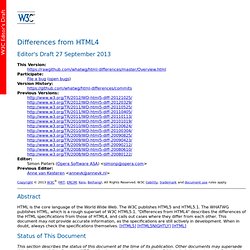

HTML5. HTML5 is a markup language used for structuring and presenting content for the World Wide Web and a core technology of the Internet.

It is the fifth revision of the HTML standard (created in 1990 and standardized as HTML 4 as of 1997)[2] and, as of December 2012[update], is a candidate recommendation of the World Wide Web Consortium (W3C).[3] Its core aims have been to improve the language with support for the latest multimedia while keeping it easily readable by humans and consistently understood by computers and devices (web browsers, parsers, etc.). HTML5 is intended to subsume not only HTML 4, but also XHTML 1 and DOM Level 2 HTML.[2] History[edit] The Web Hypertext Application Technology Working Group (WHATWG) began work on the new standard in 2004. At that time, HTML 4.01 had not been updated since 2000,[8] and the World Wide Web Consortium (W3C) was focusing future developments on XHTML 2.0. While HTML5 is often compared to Flash, the two technologies are very different.
When can I use... Support tables for HTML5, CSS3, etc. HTML5. HTML5 is a markup language used for structuring and presenting content for the World Wide Web and a core technology of the Internet. It is the fifth revision of the HTML standard (created in 1990 and standardized as HTML 4 as of 1997)[2] and, as of December 2012[update], is a candidate recommendation of the World Wide Web Consortium (W3C).[3] Its core aims have been to improve the language with support for the latest multimedia while keeping it easily readable by humans and consistently understood by computers and devices (web browsers, parsers, etc.).
HTML5 is intended to subsume not only HTML 4, but also XHTML 1 and DOM Level 2 HTML.[2] History[edit] The Web Hypertext Application Technology Working Group (WHATWG) began work on the new standard in 2004. At that time, HTML 4.01 had not been updated since 2000,[8] and the World Wide Web Consortium (W3C) was focusing future developments on XHTML 2.0. While HTML5 is often compared to Flash, the two technologies are very different. Comparison of layout engines (HTML5) The following tables compare support of HTML5 differences from HTML for a number of layout engines. Explanation of the tables[edit] Engine nomenclature[edit] Rather than the names of web browsers, the names of the underlying engines are used. The browsers that use the various engines are listed below. Values[edit] Values indicate the level of support in the most recent version of the layout engine, or (if a version number is given) in the specified version.
While many of these elements, such as section, have not been implemented natively in layout engines, support may be very easy to emulate using CSS or JavaScript. Many of these features can be emulated with third-party libraries. The WHATWG version of HTML also includes additional features that are not technically HTML5, which are described as "next-generation additions still in development" in the specification.[16] HTML5 differences from HTML4. Abstract HTML is the core language of the World Wide Web.

The W3C publishes HTML5 and HTML5.1. The WHATWG publishes HTML, which is a rough superset of W3C HTML5.1. "Differences from HTML4" describes the differences of the HTML specifications from those of HTML4, and calls out cases where they differ from each other. This document may not provide accurate information, as the specifications are still actively in development. Status of This Document This section describes the status of this document at the time of its publication. This is the 27 September 2013 Editor's Draft produced by the HTML Working Group, part of the HTML Activity. Publication as a Working Draft does not imply endorsement by the W3C Membership. This document was produced by a group operating under the 5 February 2004 W3C Patent Policy.
Table of Contents 1 Introduction 1.1 Scope of This Document This document covers the W3C HTML5 specification, W3C HTML5.1 specification, and the WHATWG HTML standard. 1.2 History of HTML <!